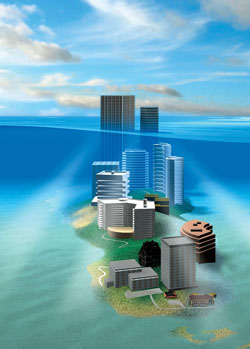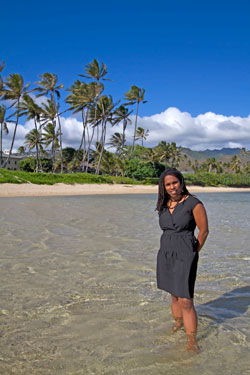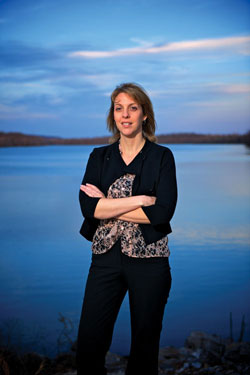Washed Away: As Sea Levels Rise, Island Nations Look to the Law to Fend off Extinction

Illustration by Bob Schuchman
The Marshall Islands—two roughly parallel chains of low-lying coral atolls that stretch across 800 miles just north of the equator—have an intensely close relationship with the Pacific Ocean that surrounds them. The full implications of that relationship were apparent in a student’s question for John M. Silk, who was serving as minister of foreign affairs for the Republic of the Marshall Islands when he visited a local community college in early 2011.
“Has the government put in place a plan if we have to evacuate the Marshall Island citizens because the islands sink beneath the waves?” the student asked.
The answer was no, and it still is. “It never occurred to the government that we would like to put in place a plan like that as a contingency,” says Silk, interviewed before leaving office following the election of a new president in January. “We would basically be abandoning our country—losing our culture and identity. This is the last thing we want to do.”
The student’s question touched on what many consider to be a very real possibility. If climate change advances the way most scientists predict, the citizens of many of the world’s small island nations may face a catastrophe of mythic proportions sometime during this century. As sea levels creep upward, those islands—like the fabled lost city of Atlantis—will sink beneath the waves.
That prospect “is now knocking at our door whether we choose to hear or not,” Silk told the attendees at a conference convened in May 2011 to discuss the impact that rising sea levels caused by climate change could have on island nations around the world. The conference, held in New York City, was co-sponsored by the Republic of the Marshall Islands and the Center for Climate Change Law at Columbia University.
“Right now, sea level rise is a reality, but also a phenomenon that currently occurs in millimeters each year,” Silk added. “But the millimeters are turning into centimeters and there are inarguable risks of long-term sea level rise of a meter or more.”
A MATTER OF METERS
How much will sea levels rise? According to Mary-Elena Carr—an oceanographer and associate director of the Columbia Climate Center, a research unit of the Earth Institute at Columbia University—recent data suggests that the polar ice sheets are melting much faster than previously thought. Meanwhile, the world’s oceans are becoming warmer, which causes water in them to expand. Together, these factors will lead to a general rise in sea levels of 1 to 2 meters—or between 3 and 6½ feet—by the end of this century, Carr estimates. In some areas, such as the South Pacific, where prevailing winds push water up against the western side of the ocean basin, sea levels are likely to rise even higher.
That kind of rise in sea levels would be devastating for low-lying island nations. The mean elevation of the five islands and 29 atolls that make up the Republic of the Marshall Islands is about 6½ feet, and the highest single point of land in the entire nation is only 33 feet above sea level.
The Marshall Islands are not alone in facing an uncertain future. The Alliance of Small Island States counts 39 nations across the globe as members.
Small island nations were quick to recognize climate change as a threat to their existence. As early as the 1980s, the alliance took an active role in negotiations leading up to the United Nations Framework Convention on Climate Change, the first formal step by the international community to consider measures for limiting emissions of carbon dioxide and other greenhouse gases.
“To a significant degree, we owe the islands for the existence of the convention,” says Mark Jariabka, the executive director of Islands First, a New York City-based nongovernmental organization that provides advice and expertise to the U.N. missions of small island nations. “They were also very instrumental in the Kyoto Protocol, and a lot of the eventual Kyoto Protocol was taken from their proposals.” (In accordance with the 1997 Kyoto Protocol, most developed nations—but not the United States—agreed to cut their emissions by 5 percent below 1990 levels.)
The Alliance of Small Island States and the 11-member Pacific Small Island Developing States were key players in the latest round of negotiations on the UNFCCC and the Kyoto Protocol, which were held last December in Durban, South Africa.
Some island nations also have begun to explore the possibility of raising the legal ante even further by asking international tribunals such as the International Court of Justice, the principal judicial organ of the U.N., to advise them on whether they have a right to protection against damage from emissions produced by other states.

Illustration by Bob Schuchman
VANISHING SOVEREIGNTY
But increasingly, small island nations are being forced to consider another urgent legal matter: If rising seas do wash over their lands, what happens to their national sovereignty, who will own their resources and where will their people go?
Island nations would die slowly rather than suddenly. Rising tides would steadily erode beaches and render the coastlines more vulnerable to the violent storms that Carr says are likely to increase in frequency and intensity as the world’s climate changes. Farms and taro patches would be inundated with seawater, and fresh water supplies would be contaminated with salt. The population would move progressively further inland to escape the waves until it eventually runs out of dry land to subsist on.
“A small island is likely to become uninhabitable long before it disappears,” says Jenny Grote Stoutenburg, an international law scholar who is a Ph.D. candidate at the University of Hamburg in Germany. And it is at the moment when the last remaining residents flee the last inhabited island that the state would cease to exist.
“In customary international law, there are four objective criteria for statehood,” says Stoutenburg. “A state must possess a defined territory, a permanent population, a government and a certain measure of independence.” There is some wiggle room—states with governments-in-exile have been recognized, as have states with governments temporarily dissolved by internal upheaval, such as Somalia—but not for the requirement that a state possess, or at least have, a legitimate claim to some inhabitable land. “It is the physical basis that allows people to live in organized communities,” she says.
It would be unprecedented for a nation to lose its statehood because its land actually disappeared, says Caleb W. Christopher, who is legal adviser to the U.N. mission of the Marshall Islands. “There’s never been a time when a government—even a small government—has vanished without somebody else coming over and taking over and succeeding it. Peru is always Peru even if another country takes it over, or if their government changes. It doesn’t just up and vanish off the face of the Earth.”
A key issue is how those nations can seek to preserve their statehood, claims to resources and national identity when they have no actual physical homeland.
Speaking at last year’s conference, Threatened Island Nations: Legal Implications of Rising Seas and a Changing Climate, Stoutenburg advised that island nations should try to keep at least some bit of land inhabitable and populated in order to anchor their claims to continued statehood.
This “population nucleus” could be very small indeed, but it should be a real community, with schools, medical services and other community institutions. “If they only have people remaining there to guard over the remaining land, you could clearly say that wouldn’t be a community anymore, and would not per se count as a state population,” Stoutenburg said in an interview with the ABA Journal.
Island nations were advised to freeze existing maritime boundaries by basing them on geographical coordinates that will not shift with retreating coastlines.
Under the U.N. Convention on the Law of the Sea, which went into force in 1994, a coastal nation’s exclusive economic zone extends 200 nautical miles (about 230 statute miles) from a baseline usually defined by the low-water line along the coast. But if this low-water line retreats as sea levels rise, the EEZ will shrink, and it will be extinguished altogether if the land becomes submerged.

Maxine Burkett, director of the Center for Island Climate Adaptation and Policy at the University of Hawaii. Photo by Darrell Wong.
But provisions in the Law of the Sea Treaty allow states to use alternate methods to draw certain maritime boundaries, and to make them permanent. Article 76(9), for instance, allows a state to freeze the boundaries of its extended continental shelf—that portion of the state’s submerged land mass that extends beyond 200 nautical miles and where the state retains exclusive mining rights —by filing maps with the U.N. secretary general. Some scholars, including Stoutenburg, think this procedure may be applied to other maritime boundaries as well, including the EEZ.
Some kind of formal international recognition or agreement would be needed to ensure support for such claims, such as an amendment or implementation agreement to the Law of the Sea Convention. This would be tough. The convention took a grueling nine years to negotiate, and 12 more years to enter into force. Many in the international community would be reluctant to reopen the treaty because “it creates the risk of unraveling the whole package deal and opening up things that they don’t want to renegotiate,” says Stoutenburg. An “easier and gentler” approach might be to seek a General Assembly resolution, she suggests.
The international community might, as a matter of justice, give island nations the benefit of the doubt and accept their claims for continued statehood and control over maritime resources, even if these claims are less than perfect, says Stoutenburg. “Ultimately, if the international community does not move quickly enough to prevent small islands from losing their effective statehood, acknowledgement of their entitlement to survive as a legal community is the least that is owed to them,” she says.
Along similar lines, Maxine Burkett, who directs the Center for Island Climate Adaptation and Policy at the University of Hawaii’s law school in Honolulu, proposed that the international community embrace a new kind of ex situ state. It would be made up of citizens scattered around the globe and headed by a government that would manage common resources, such as maritime resources and compensation funds; provide consular protection; maintain cultural ties and identity; and even keep alive the possibility of reunification in a new location.
Heady ideas, perhaps, but some island nation citizens came away from the conference dispirited. During one question-and-answer session, a highly emotional resident of the Republic of the Maldives, a cluster of atolls and islands in the Indian Ocean where the average elevation is only about 5 feet, insisted that island nations “cannot be and should not be sacrificed on the altar of the good life of the rest of the world.”
Acknowledging such sentiments, Jariabka of Islands First says that, on an abstract level, the imminent statelessness of island nation residents is “a very interesting, sexy topic to be writing about as an academic.” But, he says, “my perception was that when you had the questions and comments, some of the government officials, the people from these islands, were visibly frustrated because they were hoping to learn how to save their islands rather than how to best manage their eventual extinction.”

Michael Gerrard, director of Columbia University’s Center for Climate Change Law. Photo by Daniel Mark Bedell.
WHERE TO NOW?
For many islanders, the thought of losing their ancestral lands is devastating. “In our culture, you are born entitled to inherit your land from your father or your mother and you’re identified with the land you inherited,” says Silk. “So if you move people off from one island to the next, they will never feel comfortable because they are guests of somebody else.”
Michael B. Gerrard, the director of Columbia University’s Center for Climate Change Law who co-chaired the conference, says that, for him, one of the takeaway messages was that “the top priority for these islands was to stay there on their islands as long as they can.” Adaptation measures—such as building sea walls, reinforcing coastlines or even building artificial islands to live on—are expensive. But most of the threatened island nations appear on the U.N. list of least developed nations and cannot afford such projects.
Silk says the costs of trying to protect all of the inhabited areas in the republic would be prohibitive. “We would have to basically pick one or two or three atolls and say, ‘These are the islands we’re going to put up sea walls for. Unfortunately for you on the rest of the islands, we won’t be able to put the sea walls up.’ ”
Instead, most Marshallese will have no choice but to leave if sea levels continue to rise, according to Silk. “Either you climb a coconut tree and stay up there for the rest of your life—and starve to death, because the coconut tree will eventually die off because it’s covered with salt water—or you migrate,” he says.
But migrate where? So far, no countries have stepped up and promised to accept citizens of island nations should they be forced off their islands. As things stand now, the islanders can expect little help from the international community. The 1951 U.N. Convention Relating to the Status of Refugees, the major instrument dealing with displaced people, defines a refugee as someone with a “well-founded fear of persecution” based on “race, religion, nationality, membership of a particular social group or political opinion”—a description that wouldn’t apply to people displaced by climate change.
And climate-driven migration is very different from the kind of short-term catastrophes, like hurricanes or earthquakes, that international disaster aid organizations are designed to address. “It is not likely to happen all at once,” says Gerrard, who was 2004-2005 chair of the ABA Section of Environment, Energy and Resources. “People will sort of dribble out, which creates a different scenario and different difficulties than the mass migration scenario. It creates major problems in attempting to preserve cultural identity. You have a diaspora that is spread out over time and space.”
Anyone wondering what kinds of problems these migrants will face might look to the Marshallese who have already migrated to the United States, says D’lorah Hughes, director of the criminal clinics at the University of Arkansas School of Law in Fayetteville.
In accordance with the Compact of Free Association, under which the Marshall Islands (which had been a U.S. trust territory after the end of World War II) gained independence, Marshallese have the right to live and work in the United States visa-free, though they do not have automatic rights to citizenship. The same COFA rights apply to citizens of the Federated States of Micronesia and the Republic of Palau.
Some 4,000 Marshallese settled in northwest Arkansas, where many work at Tyson Foods plants. These migrants struggle with not only a language barrier but with cultural disconnects as well. “The family structure reliance on land-based clan ties rather than the nuclear family structure creates complications and confusion for most American agencies such as the courts, the Department of Homeland Security, the Internal Revenue Service and the school system,” Hughes says. Also, the Marshallese tradition of large families living together under one roof can run afoul of city housing codes that limit the number of people residing together.
With no experience in the use of consumer credit, Marshallese can fall prey to predatory lending schemes such as payday loans, or misunderstand the terms and responsibilities of legitimate debts. Though prone to the typical health problems of low-income people in the United States, including obesity, diabetes and heart disease, Marshallese are ineligible for most nonemergency Medicaid, Medicare and food stamps because they are not U.S. citizens.
States like Arkansas and Hawaii are left to plug the gaps. They’re starting to kick about it. On May 12, 2011, nine lawmakers—including both Arkansas senators—sent a letter to Secretary of State Hillary Rodham Clinton and Secretary of the Interior Ken Salazar calling for migrants from COFA nations to be screened for conditions such as diabetes that might lead to “an overreliance on social services” before being allowed to enter the United States.
If current climate patterns continue, the United States can expect to welcome more COFA migrants, while other island states in the Pacific might seek to expand agreements with New Zealand and Australia in order to step up migration. But for now, the governments of island nations haven’t been pushing such options, Burkett says.
In part, it’s a matter of negotiating strategy. “Australia has already suggested that it might be more efficient just to move the island nations rather than try to stop climate change,” she notes. As an island nation, “you really don’t want that on the table as a potential out.”
But Burkett also suggests that the island nations simply don’t want to contemplate abandoning their homelands, viewing migration as “an element of the death of a people.”

D’lorah Hughes, director of the criminal clinics at the University of Arkansas School of Law. Photo by John Amatucci.
RUNNING OUT OF ROAD
Whether the Marshallese and citizens of other island nations will have to deal with the disappearance of their homelands is likely to be decided at gatherings like the recently ended climate talks in Durban.
Among the significant accomplishments at that meeting was an agreement to extend the Kyoto Protocol, scheduled to expire at the end of this year, to 2017, subject to ratification of various amendments by three-fourths of the parties. (As noted, the United States, for many years the world’s biggest emitter of greenhouse gases, never ratified the Kyoto Protocol. Meanwhile, emissions from rapidly developing countries like China and India, which were exempt from binding reductions under Kyoto, soared.)
A new binding protocol would be drafted by 2015 that seeks to raise the “level of ambition” of current targets to reduce emissions that were set in 2010. A recent assessment by the U.N. Environment Program concluded that these targets would fail to keep total global warming below the United Nations Framework Convention on Climate Change goal of 3.6 degrees Fahrenheit over preindustrial levels. This goal was reaffirmed in Durban, but it will be subject to review by 2015. The Alliance of Small Island States has identified 2.7 F as the limit necessary to protect low-lying island nations.
In another action, the parties established the governing framework for a Green Climate Fund that, starting in 2020, will provide $100 billion a year to help developing countries cut emissions and adapt to climate change.
A number of national representatives praised the outcome of the talks, but Gerrard is among those who take a dimmer view of the actions taken in Durban. He describes them as “an agreement to reach an agreement in several years.” He adds, “Thus it kicked the can down the road. But for some of the island nations, there is no road left. Further delay hastens the day when they fall over the edge.”
Frustrated by this inaction, some island nations are thinking about striking out on their own, Silk says.
“We’re floating this idea of having a legally binding agreement among the most vulnerable countries—and least polluting, by the way,” says Silk. While such an agreement would have no effect on global greenhouse gas levels, “at least perhaps it will draw attention to our cause: that we need immediate solutions as a matter of security, as a matter of survival for us,” he says. “Perhaps bigger countries can afford to wait, but we can’t.”
LOOKING FOR LEGAL SOLUTIONS
On July 20, 2011, the U.N. Security Council recognized climate change as a security risk after hard lobbying by the Pacific Small Island Developing States in support of the measure. Now the PSIDS is calling for the appointment of a special representative on climate change, and for the U.N. to assess its capacity to respond to security risks associated with climate change, such as large-scale displacements of people and increased competition for dwindling resources that could fuel conflicts.
Some island nations are considering other legal options, as well. Among those options is the possibility of turning to international tribunals in search of remedies.
“We know that countries have control of their jurisdiction,” says Stuart Beck, the Republic of Palau’s ambassador to the U.N. “That they have a knowledge of the harm and they are reckless for continuing to allow the production of these harmful chemicals. These are chemicals, coming from other countries, coming to our countries and destroying our countries. So if it’s poison gas, we wouldn’t have trouble with the appropriate analogies. Damages have already occurred. They’ve been documented by the United Nations. The potential extent is existential and irremediable.”
But it’s a heavy lift for small island nations to sue the big emitters. It’s hard to prove causality when impacts are diverse and spread out in time and space, and to apportion responsibility in a world where nearly every nation is emitting at least some greenhouse gases.
Also, the tribunals that would render decisions have little power to enforce their judgments. “Country X doesn’t take country B to court in the same way that I take my neighbor to court when I don’t like the size of their fence or they have been producing things that impact my property,” says Christopher, legal adviser to the U.N. for the Marshall Islands. “Blue helmets aren’t sent to tear down smokestacks, is what I’m getting at.”
Another consideration for many small island nations, according to Jariabka, is that they are heavily dependent on aid from the very countries they are contemplating suing. “That being said, there will probably come a time—and that time may already be here—when countries have nothing to lose and they need to start looking into creative ways to demand action from the biggest polluters,” he says.
On Sept. 22, Palau and the Marshall Islands announced that they would put forth a resolution asking the General Assembly to request an advisory opinion from the International Court of Justice on the responsibilities of states to ensure that their greenhouse gas emissions do not damage other states.
The resolution will be presented formally sometime this year, says Aaron Korman, counselor to Palau’s United Nations mission.
It’s likely to be another volley in a long war. Christopher explains that, while seeking advisory opinions from tribunals may be nonbinding on the nations involved and seem ineffective, they nonetheless carry political weight and can influence the outcomes of lawsuits adjudicated elsewhere.
For example, in January 2011, when the Federated States of Micronesia called for the Czech Republic to issue an environmental statement on how the expansion of an existing Czech coal facility would impact Micronesia, it was seeking to establish a principle that nations considering projects that will increase greenhouse gas emissions should first consider their impact on other countries, Christopher says.
Speaking at the Threatened Island Nations conference, Philippine environmental lawyer Antonio Oposa called on those states to assert themselves. “I talk to some governments, and they say, ‘We’re afraid to bite the hand that feeds us,’ ” he said. “My answer is, ‘The same hand that is feeding us is also drowning us.’ ”
Kristin Choo is a freelance writer in New York City.



